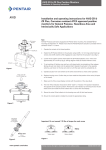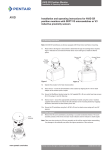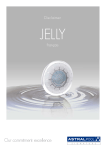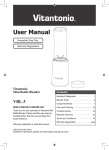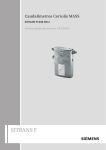Download Installation and operating instructions for AVID EaziCal IR Positioner
Transcript
AVID EaziCal IR Positioner Installation & Operating Instructions Installation and operating instructions for AVID EaziCal IR Positioner AVID EaziCal IR Positioner ModMount * Drive insert Note These devices require the provision of clean, dry, oil free instrument air, via an Air Filter Regulator with a filter mesh size of 5 microns. * Drive insert must be provided with Keystone actuators for ModMount installations. Actuator Mounting Instructions Note All AVID® Products are factory equipped with Pentair direct mounting. For standard Namur mounting see Appendix “A”. Please ensure the Pentair/Keystone actuator is provided with the standard 16 dia x 11 af drive. Figure 1 1. Operate the actuator to full closed position. 2. Fasten the EaziCal IR positioner to the actuator using (4) M5 x 12 mm hex head screws and (4) M5 washers while engaging its output shaft into the actuator’s input (figure 1). 3. Loosen the (4) captive screws which fasten the EaziCal IR Positioner cover. Twist cover approximately 45° and lift up (figure 2). (Wiring diagram inside EaziCal IR Positioner cover). 4. Ensure the correct gland is installed to provide the appropriate rating. Twist cover 45° then lift straight up Figure 2 Pneumatic Connection Outlet Port 1 Gauge Single Acting Actuator (Spring Return): For single acting actuators Outlet Port 2 is to be plugged. Outlet Port 1 is to be piped to the actuator inlet port that acts against the spring. (Increasing signal causes pressure to increase in Outlet Port 1 of the positioner). Supply gauge Double Acting Actuator (Double Return): For double acting actuators Outlet Port 2 is piped to drive the actuator towards the fail position. Outlet Port 1 is piped to drive the actuator away from the fail position. (Increasing signal causes pressure to increase in Outlet Port 1 of the positioner and pressure to decrease in Outlet Port 2 of the positioner). Supply (Inlet Port) Outlet Port 1 Outlet Port 2 Thread Identification * Figure 3 www.pentair.com/valves *Note: A ir supply to the positioner must be clean, dry, oil free instrument air (5 microns) per ISA-S7.3 and ISO 8573-1. Maximum supply pressure is 8.3 bar. All pneumatic connections are 1/4” NPT or G1/4 ISO 228. See manifold for Identification of thread type. Note * Thread Identification “B” = 1/4” BSP Without Marking = 1/4” NPT Pentair reserves the right to change the contents without notice AVDSB-0030-EN-1306 AVID EaziCal IR Positioner Installation & Operating Instructions Electrical Connection 4-20 mA Input (-) The electrical connection (4-20 mA Loop Input) to the EaziCal positioner is polarity sensitive. Connect the 4-20 mA Loop Input to terminal block J1 on the Connector Board as shown below (Positive lead to terminal point 3 and negative lead to terminal point 2). The wire size can range from 20 to 14 AWG. J1 is removable (plugs into a pin header soldered to the PCB) for ease of wiring and service. 4-20 mA Input (+) Conduit Opening Dip Switches Dip switch #1 Off Position (Factory Setting): Normal Acting (4 mA represents zero/Fail position and 20 mA represents Span position). On Position : Reverse Acting (20 mA represents zero/Fail position and 4 mA represents Span position). Dip switch #2 Off Position: Enables the security code requirement for IR Remote operation. On Position (Factory Setting): Disables the security code requirement (Infrared remote can be used without security code). Dip Switch #1 Dip Switch # 2 Dip Switches shown in factory set positions Position Sensor Gear Position Sensor Initial Angle (Setting Mode) The EaziCal’s Position Sensor, which measures the absolute position of the valve, has a limited operating angle for proper position measurement. The Position Sensor must remain within the operating angle in both the open and fail valve positions. This is accomplished by initially setting the Position Sensor angle while the valve is in the fail position. The EaziCal has a mode of operation to accomplish the setting of this initial angle using the following steps. 1. Apply loop current to the positioner and adjust to 12 mA. 2.Press & hold both the high and low buttons until the yellow and green LED’s begin to flash. Release both buttons to remove air pressure from Outlet Port 1. 3.If the valve fails clockwise and strokes counter-clockwise, then set switch SW1 to the CCW position. If the valve fails counter-clockwise and strokes clockwise, then set switch SW1 to the CW position (see figure below). 4.With no buttons pressed and the actuator in the fail position, push the Main Shaft Gear (larger of the two) down until it disengages from its shaft locking position. 5.Rotate the Main Shaft Gear (both gears will turn), until only the green LED is flashing. Note: If the LED is already green, skip 5 and go to 6. 6.Pull up the Main Shaft Gear allowing it to re-engage on the shaft locking it into position. 7.Press and hold the High Calibration button until the valve fully strokes away from the fail position while watching the LED’s. The red or yellow LED’s must not light as long as the High Cal button is being held down. If the red or yellow LED lights while the High Cal button is being held down, then the Position Sensor Orientation and Actuator air piping are out of phase. Correct the phase error by changing the position of SW1 and repeat this procedure starting from step 2. 8.Release the High Calibration button and watch the red LED. The red LED will flash until the valve reaches the fail position. 9.Press the Low Calibration button to exit the Position Sensor Setting Mode (if no buttons are pushed then this mode will time out automatically in approx. 2 minutes). Pentair reserves the right to change the contents without notice Figure 4 page 2 Switch (SW1) Main Shaft Gear FAULT CAL/ SLEW NORMAL LOW CAL FCTN HIGH CAL Figure 5 AVID EaziCal IR Positioner Installation & Operating Instructions Special note Flow Capacity EaziCal standard flow design is suitable for actuator swept volumes of a minimum 60 inch3 (0.98 liters) to a maximum of 225 inch3 (3.7 liters) for proper Auto Calibration functionality. It should also be noted that this is to be used as a general guideline only. The actuator/ valve package dynamics would dictate the success of the Auto calibration routine and could be compromised by the following: instrument air supply volume capacity, actuator sizing, tubing size and actuator/valve health. EaziCal optional high flow design is suitable for actuator swept volumes of a minimum 200 inch3 (3.3 liters) to a maximum of 600 inch3 (9.8 liters) for proper Auto Calibration functionality. It should also be noted that this is to be used as a general guideline only. The actuator/ valve package dynamics would dictate the success of the Auto calibration routine and could be compromised by the following: instrument air supply volume capacity, actuator sizing, tubing size and actuator/valve health. Calibration complete: **For split range enter desired input values during low and high calibration. Calibrating The EaziCal Positioner Once the EaziCal and actuator have been connected and the initial angle has been set. Low and High Calibration can be performed on the EaziCal. Low Calibration refers to the input current value that drives the valve into the fail position. High Calibration refers to the input current value that drives the valve into the Span Position. Calibration adjusts parameters internal to the EaziCal that are specific to the actuator, and input current values. The parameters that are adjusted are, the Gain of the EaziCal servo loop. The end position (Zero/Span) of the valve travel, and Drop-Off point (input current level at which the transducer is forced to the extreme position, to insure that the valve is fully open or closed). The calibration routine uses the input current value to set its internal adjustment, so it is important that the input current does not change during the calibration routine. ** To Do a Low Calibration: (Zero Position) 1. Set the Input Current level to the value that drives the valve into the fully closed position (typically 4 mA). 2.Start the Low Calibration routine by pressing and holding the LOW CAL button on the EaziCal until the Yellow LED flashes or by pressing the LOW button on the IR Remote (may require security code entry). 3.Observe the flashing Yellow LED on the EaziCal which denotes the various stages of the calibration routine: a. Flashing 1 time indicates Coarse Gain routine. b. Flashing 2 times indicates Fine Gain routine. c. Flashing 3 times indicates Zero position set routine. d. Flashing 4 times indicates Low Drop-Off routine. 4.When the Green LED begins to flash the Calibration is completed. If the Red LED flashes this is an indication that one of the Calibration routines could not be completed. The number of Red LED flashes indicates the calibration routine that failed. ** To Do a High Calibration: (Span Position) 1. Set the Input Current level to the value that drives the valve into the fully open position (typically 20 mA). 2.Start the High Calibration routine by pressing and holding the HIGH CAL button on the EaziCal until Yellow LED flashes or by pressing the HIGH button on the IR Remote (may require security code entry). 3.Observe the flashing Yellow LED on the EaziCal which denotes the various stages of the calibration routine: a. Flashing 1 time indicates Coarse Gain routine. b. Flashing 2 times indicates Fine Gain routine. c. Flashing 3 times indicates Span position set routine. d. Flashing 4 times indicates High Drop-Off routine. 4.When the Green LED begins to flash the Calibration is completed. If the Red LED flashes this is an indication that one of the Calibration routines could not be completed. The number of Red LED flashes indicates the calibration routine that failed. Advanced Functions The EaziCal has the ability to change the calibration settings (Gain, Zero, Span, and Drop-off) manually. This function was intended to make minor changes in the calibration values after doing the Low and High calibration. Some examples where this might be used are decreasing the Gain if the valve still shows some overshoot on rapid position changes, or increasing the High Drop-off point so it will not be in effect at 20mA. Exercise caution if using the manual calibration, mis-adjustment of these settings on the EaziCal positioner can result in erratic behavior or failure of operation, and may require resetting the EEPROM before auto-calibration can be performed again. To Do a Manual Calibration Adjustment: 1. Apply Input Current to the EaziCal (typically 12 mA). 2.Start the Manual Calibration routine by pressing and holding the Function (centre) button on the EaziCal until the Green and Yellow LED flashes. 3.Observe the flashing Green and Yellow LEDs on the EaziCal. The number of flashes denotes the various stages of the manual calibration routine. Pressing the Function (centre) button again advances to the next stage: a. Flashing twice indicates Manual Gain adjustment. b. Flashing 3 times indicates Zero position adjustment. c. Flashing 4 times indicates Low Drop-off adjustment. d. Flashing 5 times indicates Span position adjustment. e. Flashing 6 times indicates High Drop-off adjustment, Pentair reserves the right to change the contents without notice page 3 AVID EaziCal IR Positioner Installation & Operating Instructions 4. To alter any characteristics of the positioner follow the following steps: a. Manual gain Increase the positioner gain by pressing the High Cal button. Decrease the positioner gain by pressing the Low Cal button. Continue to increase or decrease the gain by repeatedly pressing the buttons. The maximum adjustment has been achieved when the red LED lights. b. Zero position [To adjust the zero position to a point other than the hard stop of the valve the Low calibration of the positioner must have been performed at a current slightly lower than the zero position current. (Ex. If the zero position current is 4.0 mA the Low Calibration as described in the previous section needs to be performed at 3.9 mA.)] Increase the zero position by pressing the Low Cal button. Decrease the zero position by pressing the High Cal button. Continue to increase or decrease the zero position by repeatedly pressing the buttons. c. Low Drop-Off Increase the mA input signal that the positioner drops output port 1 pressure by pressing the Low Cal button. Decrease the mA input signal that the positioner drops output port 1 pressure by pressing the High cal button. Continue to increase or decrease the drop-off position by repeatedly pressing the buttons. d. Span Position [To adjust the span position to a point other than the hard stop of the valve the High calibration of the positioner must have been performed at a current slightly higher than the span position current. (Ex. If the span position current is 20.0 mA the High calibration as described in the previous section needs to be performed at 20.1 mA.)] Decrease the span position by pressing the High Cal button. Increase the span position by pressing the Low Cal button. Continue to increase or decrease the span position by repeatedly pressing the buttons. e. High Drop-Off Decrease the mA input signal that the positioner drops output port 2 pressure by pressing the High Cal button. Increase the mA Input signal that the positioner drops output port 2 pressure by pressing the Low Cal button. Continue to increase or decrease the drop off position by repeatedly pressing the buttons. 5. The Input Current can be changed during the test to observe the adjustment effects on the EaziCal behavior. 6. To save the adjustments and exit the Manual Calibration Mode the Function (center) button must be held for approximately 5 seconds (green and yellow flashing LED’s will change to flash just green when adjustments are saved). This procedure to save and exit can be performed from any stage during the Manual Calibration. 7. Pressing the Function (Center) button during the High Drop-Off adjustment exits the Manual Calibration Mode without saving any adjustments made. HiVue Visual Indicator Valve Open Valve Closed Figure 6 Setting The HiVue Visual Indicator 1. Replace cover and secure the (4) captive screws. Confirm that you have noted the final position of the valve, (full open or full closed). 2. Make sure the HiVue visual indicator coincides with the position of the valve (figure 6). 3. The inner HiVue indicator should show either “Open” or “Closed”. If the position indicated is the opposite of the actuator position, remove the (4) slot head screws that secure the HiVue indicator cover and rotate the indicator cover 90° so the proper symbol for the position of the valve is displayed (figure 7). 4. Secure the visual indicator cover to the housing cover using the (4) slot head screws. Slot Head Screw HiVue Visual Indicator Cover Housing Cover HiVue Visual Indicator Figure 7 Important: Do not exceed 1.13 Nm of torque for each screw. Pentair reserves the right to change the contents without notice page 4 AVID EaziCal IR Positioner Installation & Operating Instructions The (IR) Remote Control With The Positioner The positioner has the ability to be operated (calibrated) via an Infrared (IR) Remote Control. The positioner can be calibrated by using the buttons on the positioner module, however this requires the removal of the top cover. With the (IR) Remote Control the positioner can be calibrated without the removal of the top cover. If the 4-20 mA input current connected to the positioner is not available or the Position Sensor Initial Angle must be set then the removal of the top cover is required. Although the positioner is configured for use with the remote, the (IR) Remote Control is not provided with the positioner. The (IR) Remote Control is an option and must be purchased separately. The IR Remote Control Buttons PROGRAMMING BUTTON Used for the initial setup of the IR Remote BACKLIGHT BUTTON Turns the IR Remote backlight on and off RED LED Lights when IR signal is being sent 'D' POWER P1 P2 + HIGH - DROP-OFF LOW MODE BUTTONS Enables one of the two modes, which remains in effect until another one of these buttons is pressed. P2 mode is the one used for the positioner. HIGH CALIBRATE BUTTON Used to begin the high calibrate routine GAIN LOW CALIBRATE BUTTON Used to begin the low calibrate routine Programming The IR Remote Control The IR Remote Control is programmed at the factory and should not need to be programed again, unless the batteries are removed for an extended period of time (greater than 10 minutes). To program the IR Remote press the “P1” button then press and hold the “P” button until the red LED blinks twice, then press “0”, “0”, “8”, “1” after which the red LED on the IR Remote blinks twice to confirm the entry. Press the “P2” button then press and hold the “P” button until the red LED blinks twice, then press “0”, “0”, “5”, “4” after which the red LED blinks twice to confirm the entry. NUMERIC BUTTONS Used to select the 3 digit code for the positioner security address MANUAL ENTER B A C EXIT UNDO Figure 8 ENTER BUTTON Used to enter the 3 digit code for the positioner security address Using The IR Remote Control The positioner has two operating modes when using the IR Remote. In the first mode, the positioner will immediately act upon commands from the IR Remote (this can be used when the positioner being calibrated is the only one that will be within range of the IR Remote signal, such as one positioner in a closed room). This mode is enabled by setting the positioner DIP switch position 2 (the one closest to the Low Cal Button) to the “ON” position (away from the LED’s). In the second mode, the positioner will not act upon commands from the IR Remote until a 3 digit security code is entered (this can be used when there are multiple positioner’s within range of the IR Remote signal). This mode is enabled by setting the positioner DIP switch position 2 (the one closest to the Low Cal button) to the “OFF” position (toward the LED’s). Once the correct code is entered (3 digits followed by the ENTER button) the positioner is enabled to act upon IR Remote commands for 5 minutes. The IR Comand Enable time counts down to zero, or is set to zero (positioner no longer acts upon commands) when the positioner gets an ENTER from the IR Remote, that was not preceded by the correct 3 digit security code. Pentair reserves the right to change the contents without notice page 5 AVID EaziCal IR Positioner Installation & Operating Instructions Setting The Positioner Security Code The security code is initially set by entering a 3 digit code, while the positioner is in the “Position Sensor Initial Angle” setup mode. To set a security code enter “Position Sensor Initial Angle” setup mode, by pressing and holding the High and Low Calibration buttons on the positioner until the Yellow and Green LED’s flash. Press the 3 digits for the security code on the IR Remote then press the ENTER button on the IR Remote (entering the code too quickly may prevent the positioner from reading it correctly, pause at least 1/2 second between each button pressed and hold each button down for at least 1/2 second on the IR Remote). When the Low Calibration button on the positioner is pressed to exit the “Position Sensor Initial Angle” setup mode the 3 digit security code is stored in the EEPROM and will remain there even if power is removed. Make sure that the security code you assign is different for each of the positioner’s in the area. Resetting the EEPROM Back to Factory Default Values The positioner has an internal Electrically Erasable Programmable Read Only Memory (EEPROM) that is used to store the calibration values and the IR Remote security code. These values remain in the EEPROM memory even if power is removed from the positioner. During normal operation of the positioner the EEPROM will not have to be reset. The memory may become corrupted if power to the positioner is lost while the positioner is writing to the EEPROM, which only happens at the very end of the calibration cycle or at the end of the Position Sensor Initial Angle setup. This memory can be reset back to factory default values by holding down the HIgh Cal button while the positioner is being powered up. After the EEPROM is reset, the positioner will have to be calibrated again and the IR Remote security code will have to be set again. Reversing the 4mA and 20mA Positions (Reverse Acting) Normally 4mA of input current represents the closed valve position and 20mA represents the open valve position. The positioner has the option to switch this so 20mA represents the closed valve position and 4mA represents the open valve position. The normal mode is chosen by setting the positioner DIP Switch position 1 (the one closest to the LED’s) to the “OFF” position (toward the LED’s). The reverse acting mode is chosen by setting the positioner DIP switch position 1 to the “ON” position (away from the LED’s). The positioner should be calibrated again every time the switch position is changed. Top Cam Push down turn & release Setting of the Switches 1. Operate the actuator to one extreme. Choose the switch you would like to signal this position (upper or lower switch). Disengage the appropriate switch cam from the spline by pushing or pulling against the spring (push down for the upper switch, lift up for the lower switch). 2.Turn the cam until the switch is activated. Activation of the switch can be monitored using a continuity tester or equivalent means. 3.Release the cam allowing it to re-engage with the spline. 4.Operate the actuator to the opposite extreme and repeat steps 1 through 3 for the other switch. Wiring Schematic SWITCH NC #1 UPPER NO Bottom Cam Lift up turn & release Figure 9 C SWITCH NC #2 LOWER NO C BROWN PURPLE YELLOW ORANGE BLUE RED 1 2 3 4 5 6 GND Pentair reserves the right to change the contents without notice page 6 AVID EaziCal IR Positioner Installation & Operating Instructions EaziCal parts description Item # Qty 3 Description 11Housing Assembly 2 1 Shaft Assembly 3 1 Cover Assembly 41 ModMount 5 1 Manifold Assembly 6 1 Electronic Assembly 7 1 Connector Board Assembly 8 1 Motor Assembly 9 1 Mechanical Switch Assembly 10 1 Output Transmitter Gear * 7 8 2 5 6 1 Figure 10 Optional mechanical switch assembly or proximity sensor 4 9 Electro-Pneumatic Positioner Transmitter Calibration Procedure 1. Calibrate the Positioner per the operating manual provided with the product. 2. Stroke the valve to the fully clockwise extreme. 3. Depress the main shaft gear disengaging it from its locking position, take extreme care not to turn the main shaft gear, as this will take the psoitioner out of calibration. 4. With the main shaft gear depressed turn the transmitter gear to the fully counter clockwise position, and note the reading (mA) of the transmitter. Next, turn the transmitter gear clockwise until the transmitter changes no more than 0.5 mA from previous reading. 5. Turn the clockwise mA adjustment screw to adjust the transmitter reading to the desired output for this valve position (typically this is 4 mA or 20 mA). 6. Stroke the valve to the fully counter clockwise extreme. 7. Turn the counter clockwise mA adjustment screw to adjust the transmitter reading to the desired output for this valve position. 8. Stroke the valve between the full clockwise and counter-clockwise positions checking and readjusting the (mA) output as necessary. Main shaft Note Main shaft gear Only switches or retransmission is available. They are not available together. mA adjustment screw for clockwise position Transmitter output terminals 1 and 2 (not polarity dependent) * Output Transmitter gear mA adjustment screw for counter-clockwise position Figure 11 Pentair reserves the right to change the contents without notice page 7 AVID EaziCal IR Positioner Installation & Operating Instructions Technical data Operating Specifications Input Current Voltage Drop Supply Air Pressure Resolution Linearity Hysteresis Repeatability Thermal Coefficient Output Flow Rate Air Consumption Operating Temp. Range Gain Air Connection Ports Input Impedance 4 to 20 mA (analogue) 9 volts (low) 1 to 3 bar (high) 2.6 to 7.8 bar 0.5% of span ±1% of span 0.4% of span 0.4% of span 3%/100°C 458 l/m at 6.2 bar 0.225 l/m at 6.2 bar -40°C to 85°C (-40°F to 185°F) Electrically Adjustable 1/4” NPT/G1/4 ISO 228 400 ohms 15 to 45 psi 40 to 120 psi Materials of Construction Housing Engineered Resin (Nylon) Cover Clear Engineered Resin (Nylon) Shaft Stainless Steel Fasteners Stainless Steel HiVueCopolyester ModMount Engineered Resin (Nylon) Manifold Anodized Aluminum V3 Mechanical Switches Electrical Version Electrical Rating SPDT form C 15 amps/125/250 VAC 6 amps/24 VDC 0.5 amps/125 VDC 0.25 amps/250 VDC Area Classification & Approvals Weatherproof IP 66 General purpose Proximity Type Inductive Sensors • Proximity Type Inductive Sensors are available in 2 or 3-wire DC (5-36 VDC) PNP/NPN (NO/NC) or 2-wire AC/DC (20-140 AC/10-140 DC) configurations. • Sensors are available in flush mount rectangular configurations. Enclosures Conduit entries 1 x 1/2” NPT 1 x M20 (note 1) Note 1 2 x M20 when switches/sensors are supplied Pentair reserves the right to change the contents without notice page 8 AVID EaziCal IR Positioner Installation & Operating Instructions Dimensions (mm) - EaziCal IR Positioner - with Pentair Direct Mounting M20 PG 13.5 1/2” NPT 59 dia. 190 54 133 151 93 98.8 67 ModMount Actuator 130 108 19 Side View 11 Top View 40.1 CRS 93.5 CRS M5 Clearance holes 19.0 ø 16.0 11.0 Flat Figure 12 Standard Pentair/Keystone output shaft Appendix “A” Instructions for EaziCal IR Positioner Mounting using standard Namur output: 1. Remove Pentair direct mounting bracket assembly from the EaziCal IR Positioner. Note: The EaziCal IR Positioner are equipped with a standard Namur output shaft. 2.Replace bracket assembly with a standard Namur mounting bracket. Note: Standard Namur mounting bracket is not included. Namur shaft details Pentair reserves the right to change the contents without notice page 9









